|
|
|
Sort Order |
|
|
|
Items / Page
|
|
|
|
|
|
|
| Srl | Item |
| 1 |
ID:
151610
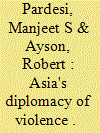

|
|
|
|
|
| Summary/Abstract |
Military coercion has already changed the Asia-Pacific region.
|
|
|
|
|
|
|
|
|
|
|
|
|
|
|
|
| 2 |
ID:
114507
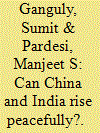

|
|
|
|
|
| Publication |
2012.
|
| Summary/Abstract |
This article provides a brief overview of the theoretical literature on the rise of China, and then explores the implications of the rise of China for the U.S.- China rivalry. It then describes sources of underlying tensions in the Sino-Indian relationship. China and India are not only engaged in a competition for power and influence in Asia, but they are also locked in a particularly contentious border dispute. The authors then argue that economic interdependence may not be enough to offset the sources of conflict in the Sino-Indian rivalry. This holds true in spite of the presence of nuclear weapons by both sides in this dyad. Therefore, a limited conventional war remains a distinct possibility even though it is by no means inevitable.
|
|
|
|
|
|
|
|
|
|
|
|
|
|
|
|
| 3 |
ID:
140977
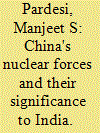

|
|
|
|
|
| Summary/Abstract |
The Indian nuclear program is a response to a perceived politico-strategic threat from China as opposed to a military-operational one that New Delhi began after perceiving an “ultimatum” from China in 1965. Consequently, India is in the process of acquiring an assured second-strike capability vis-à-vis China to meet the requirements of general deterrence. While India has always been concerned about the Sino-Pakistani nuclear/missile nexus, China has become wary of the growing military ties between the United States and India in recent years, especially because of the military implications of the US-India civil nuclear deal. Given the growing conventional military gap between the two states, India is not lowering its nuclear threshold to meet the Chinese conventional challenge. Instead, India is upgrading its conventional military strategy from dissuasion to deterrence against China. While the overall Sino-Indian nuclear relationship is stable, it will be challenged as China acquires advanced conventional weapons that blur the distinction between conventional and nuclear conflict.
|
|
|
|
|
|
|
|
|
|
|
|
|
|
|
|
| 4 |
ID:
096806
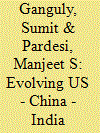

|
|
|
| 5 |
ID:
087511


|
|
|
|
|
| Publication |
2009.
|
| Summary/Abstract |
This paper will provide a survey of India's foreign policy from 1947
to the present day. It is divided into three distinct historical sections.
It will also attempt to explain the underlying reasons for these policies,
India's initial orientation, and subsequent shifts that occurred over
time. The first section deals with the period from 1947 to 1962, the
second from 1962 to 1991 and the third from 1991 to the present. The
choice of these three segments is far from arbitrary. The first period
constituted the most idealistic phase of India's foreign policy under
the tutelage of India's first Prime Minister, Jawaharlal Nehru. The
second began with India's disastrous defeat in the 1962 Sino-Indian
border war. This period saw a gradual shift away from the early idealism
that had characterized the country's foreign policy and the adoption
of an increasingly "self-help" approach to foreign policy while retaining
elements of the Nehruvian rhetoric.1 The third phase began with the
end of the Cold War and the adoption of a more pragmatic foreign
policy hewing closely to the principles of Realism.
|
|
|
|
|
|
|
|
|
|
|
|
|
|
|
|
| 6 |
ID:
178859
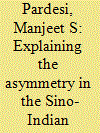

|
|
|
|
|
| Summary/Abstract |
China views India as an asymmetric (‘lesser’) rival that has the ability to obstruct China’s grand strategic goals. China’s long-term goals are domination in East Asia followed by Asia-wide domination, and finally global pre-eminence. The asymmetric dimension of their rivalry is rooted in the ego-relevancy cognitive bias in the Chinese elites’ perceptions of Indian history and statehood. Consequently, China does not consider India as a ‘peer’. This perceptual dimension pre-dates their material power asymmetry. Nevertheless, China perceives India as an ‘imperial’ rival that interferes in China’s Tibet. Furthermore, India’s ‘hegemonic’ ambitions in Southern Asia pose a challenge for China at the pan-Asian level, and may even undermine Chinese domination in East Asia. Thus understood, there are three implications for the Sino-Indian rivalry. First, the positional and territorial dimensions of their rivalry are now intertwined and will be difficult to resolve. Second, this is not just a dyadic rivalry as it will interact with their relations with the United States, Japan, and Pakistan, thereby creating new uncertainties. Finally, the military undertones of this rivalry are spilling over into other regional countries. This rivalry will intensify if India pursues internal or external balancing, or if India charts a distinct path to politico-economic modernisation.
|
|
|
|
|
|
|
|
|
|
|
|
|
|
|
|
| 7 |
ID:
095674
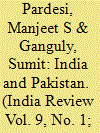

|
|
|
| 8 |
ID:
078115
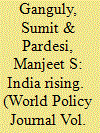

|
|
|
| 9 |
ID:
176231
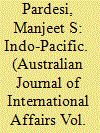

|
|
|
|
|
| Summary/Abstract |
The term ‘Indo-Pacific’ has now entered the strategic lexicon to refer to strategic Asia. In contrast to the dominant themes in the scholarly literature that emphasise its ‘newness’ and conceive it as a maritime space, I argue that Asia's three sub-regions (South, Southeast, and Northeast Asia) and two oceans (Indian and Western Pacific) have constituted a single strategic system for the past two centuries (with the notable exception of the last three decades of the Cold War). Importantly, future regional order in this ‘larger Asia’ will emerge from the interdependence of continental and maritime power. Approaching International Relations as an historical social science, I construct a new historical narrative to explain region (trans)formation. This larger strategic Asia that first emerged around the time of the ‘great divergence’ between the West and the rest was created by a rising Britain through its Indian base. While Cold War geopolitics ‘split’ Asia into smaller sub-regions, the rise of China and India is reversing this split. The contemporary re-emergence of the Indo-Pacific allows the United States to create a regional distribution of power and a regional distribution of status (through discourse) that favours the United States in an increasingly multipolar region.
|
|
|
|
|
|
|
|
|
|
|
|
|
|
|
|
| 10 |
ID:
169248


|
|
|
|
|
| Summary/Abstract |
Sino-Indian interactions after the mid-19th century had a causal influence on Chinese and Indian elite perceptions. Modern China encountered modern India as an agent of British imperialism. China perceived India as an “imperial” power in the late 1940s by resorting to the availability heuristic while doubting India’s intentions in Tibet/Southeast Asia. By contrast, India viewed China as a fellow victim of colonialism that had sought India’s help during World War II. Consequently, India perceived China as a “partner” in postwar/postcolonial Asia. This interpretation was based on confirmation bias after 1947, despite contradictory Chinese signals. India’s image of China changed only after the 1950–51 invasion/annexation of Tibet. India then ascribed the image of an “expansionist/hegemonic” power to China based on historical analogy. Nevertheless, they carefully calibrated their strategies towards each other in consonance with these images until the 1959 Lhasa Uprising, thereby preventing their relationship from descending into militarized hostilities.
|
|
|
|
|
|
|
|
|
|
|
|
|
|
|
|
| 11 |
ID:
137399
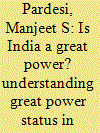

|
|
|
|
|
| Summary/Abstract |
The traditional approaches to great power status - the intuitive criteria, an emphasis on warfare, and system-/global-level capabilities - have serious limitations. These approaches have ignored the implications of the expansion of the European states-system into a global one along with the simultaneous regionalization of world politics. Therefore, a threefold criterion for great power status is proposed - the presence of security-related and economic interests outside of a state's home region, the requisite capabilities, and the demand for this status and its acceptance by other great powers and the regional states. India has emerged as a great power because it meets these criteria in Southeast Asia. India's transformation from a South Asian power into one capable of shaping the regional order in Asia is of theoretical significance.
|
|
|
|
|
|
|
|
|
|
|
|
|
|
|
|
| 12 |
ID:
170898


|
|
|
|
|
| Summary/Abstract |
How did China and India manage to prevent the 1986-87 Sumdorong Chu Crisis from escalating into a war? I argue that it was a combination of changing geopolitical factors (Sino-Soviet rapprochement and the end of Soviet support for India in the context of Sino-Indian tensions) and military factors (conventional deterrence and perceptions of limited revisionism) that help explain crisis management. While these geopolitical and military factors helped avert immediate escalation, the crisis truly ended only after China and India sought a new modus vivendi during Prime Minister Rajiv Gandhi’s landmark trip to China in December 1988. The absence of great power (Soviet) support meant that India had to make a costly signal to China in the form of Gandhi’s trip that happened during the 1987-89 cycle of protests in Tibet against Chinese rule. Nevertheless, Gandhi’s visit took place after India had demonstrated its military strength and resolve in its ability to defend the status quo on the border, and therefore should not be interpreted as a sign of weakness. In other words, I argue that successful deterrence requires broader foreign policy reorientation. At the same time, considerations of power (in the form of internal/external balancing) are central to strategic stability in the Sino-Indian dyad, and that any recourse to diplomacy that ignores the realities of military power is unlikely to be successful for crisis managemen
|
|
|
|
|
|
|
|
|
|
|
|
|
|
|
|
| 13 |
ID:
153953
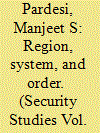

|
|
|
|
|
| Summary/Abstract |
This article introduces early modern Islamicate Asia (∼1500–1750) as an international system. Three theoretical insights emerge from an analysis of the international relations of the Mughal Empire, the system's largest polity/economy. First, hierarchies are not necessarily peaceful because the system's structural attributes—polarity, the presence/absence of regions, and the pattern of interunit relations—remain important causal factors. Second, asymmetric material capabilities do not imply unequal relationships because the initiation of state-making policies that others emulate enhances the structural power of the initiator. Finally, systemic stability is reinforced when the interaction of trade, finance, and military power affirm the system's economic and security orders. These findings have implications for the expansion of Europe, for the study of world history, and for the emerging world order.
|
|
|
|
|
|
|
|
|
|
|
|
|
|
|
|
| 14 |
ID:
081029


|
|
|
|
|
| Publication |
2008.
|
| Summary/Abstract |
This paper systematically analyzes the origins and emergence of the Hindu nationalist Bharatiya Janata Party (BJP) in Indian politics, and its impact on secularism, domestic politics, and foreign policy. We contend that it was the institutional context of Indian politics in the 1980s, and not Hindu nationalist political ideology per se, that facilitated the emergence of the BJP. India's democratic institutions, particularly coalition politics, have moderated the BJP's radical policy goals. As such, the BJP does not pose a threat to the functioning of the Indian democracy. However, with its long-term goal to redefine Indian nationhood, and its dependence on the Rashtriya Swayamsevak Sangh (RSS) cadre for electoral success, the party's militant and violent agenda against minorities, especially Muslims, remains intact. The BJP's single major success has been the communalization of Indian politics by changing the discourse on secularism. In spite of its nationalist and aggressive rhetoric, there was no substantive change in India's foreign and security policies under the BJP-led National Democratic Alliance (1999-2004). More broadly, this paper demonstrates that religion and democracy have always been in a dialectic in the Indian context. After all, India's nominally secular Congress party has used religious symbolism for electoral gains. As such, the equilibrium between religion and democracy needs to be constantly negotiated in India
|
|
|
|
|
|
|
|
|
|
|
|
|
|
|
|
| 15 |
ID:
097316


|
|
|
|
|
| Publication |
2010.
|
| Summary/Abstract |
This article argues that in contradiction to the conventional wisdom that the Sino-Indian rivalry is one-sided (with only India viewing China as a rival); China has always factored India in its strategic calculus. The Sino-Indian relationship is asymmetric only to the extent that while India regards China as its 'principal rival', China considers India as only one of its (many) 'strategic rivals' as opposed to the principal one. This article also analyses articles related to India published in English-language Chinese journals in recent years. The analysis shows that China has now begun to regard India as a major emerging power and an important player in the emerging strategic architecture of the Asia-Pacific region (as opposed to a mere South Asian player).
|
|
|
|
|
|
|
|
|
|
|
|
|
|
|
|
|
|
|
|
|